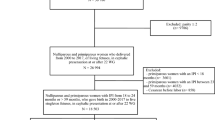Abstract
Objective
To determine whether interpregnancy interval after the first spontaneous abortion has an effect on reproductive performance of women in their next pregnancy.
Method
A prospective cohort study was conducted on 4,619 women with history of spontaneous abortion in their first pregnancy. Of them 2,422 (52.4 %) conceived within 6 months of the miscarriage (group A) and 2,197 47.6 % after 12 months (group B). The primary outcome was abortion, live birth, termination, or ectopic pregnancy in the next pregnancy. Secondary outcomes were preterm delivery, low birth weight infants, caesarean section rate and occurrence of preeclampsia, placental abruption and induced labour in the second pregnancy.
Results
Women who conceived again within 6 months were less likely to have another abortion, termination, or ectopic pregnancy compared with women with interpregnancy interval more than 12 months. Women with an interpregnancy interval more than 12 months were less likely to have live birth in the second pregnancy and more likely to have a caesarean section, preterm delivery, or infant of low birth weight compared with women who conceived again within 6 months.
Conclusions
Women who conceive within 6 months after their first spontaneous abortion have better reproductive outcomes and the lowest complication rates in their subsequent pregnancy.
Similar content being viewed by others
Change history
21 November 2023
An Editorial Expression of Concern to this paper has been published: https://doi.org/10.1007/s00404-023-07268-2
References
Wilcox AJ, Weinberg CR, O’Connor JF, Baird DD, Schlatterer JP, Canfield RE (1988) Incidence of early loss of pregnancy. N Engl J Med 319:89–94
Bhattacharya S, Townend J, Shetty A, Campbell D, Bhattacharya S (2008) Does miscarriage in an initial pregnancy lead to adverse obstetric and perinatal outcomes in the next continuing pregnancy? BJOG 115:1623–1629
Regan L, Braude PR, Trembath PL (1989) Influence of past reproductive performance on risk of spontaneous abortion. BMJ 299:541–545 (Erratum: BMJ; 299:1082)
Goldstein RR, Pruyn MA, Croughan MS, Robertson PA (2002) Neonatal outcomes in immediate versus delayed conceptions after spontaneous abortion: a retrospective case series. Am J Obstet Gynecol 186:1230–1236
Wyss P, Biedermann K, Huch A (1994) Relevance of the miscarriage—new pregnancy interval. J Perinat Med 22:235–241
Rud B, Klunder K (1985) The course of pregnancy following spontaneous abortion. Acta Obstet Gynecol Scand 64:277–278
Hathout H, Kasrawi R, Moussa MA, Saleh AK (1982) Influence of pregnancy outcome on subsequent pregnancy. Int J Gynaecol Obstet 20:145–147
Franche R, Bulow C (1999) The impact of a subsequent pregnancy on grief and emotional adjustment following a perinatal loss. Infant Ment Health J 20:175–187
Conde-Agudelo A, Belizan JM, Breman R, Brockman SC, Rosas-Bermudez A (2005) Effect of the interpregnancy interval after an abortion on maternal and perinatal health in Latin America. Int J Gynaecol Obstet 89:34–40S
World Health Organization (2005) Report of a WHO technical consultation on birth spacing
Zhu BP, Le T (2003) Effect of interpregnancy interval on infant low birth weight: a retrospective cohort study using the Michigan maternally linked birth database. Matern Child Health J 7:169–178
Zhu BP, Rolfs RT, Nangle BE, Horan JM (1999) Effect of the interval between pregnancies on perinatal outcomes. N Engl J Med 340:589–594
Conde-Agudelo A, Belizan JM (2000) Maternal morbidity and mortality associated with interpregnancy interval: cross sectional study. BMJ 321:1255–1259
Aref-Adib M, Freeman-Wang T, Ataullah I (2008) The older obstetric patient. Obstet Gynaecol Reprod Med 18:43–48
Nabukera SK, Wingate MS, Salihu HM, Owen J, Swaminathan S, Alexander GR et al (2009) Pregnancy spacing among women delaying initiation of childbearing. Arch Gynecol Obstet 279:677–684
Smits L, Essed G (2001) Short interpregnancy intervals and unfavourable pregnancy outcome: role of folate depletion. Lancet 358:2074–2077
DaVanzo J, Hale L, Razzaque A, Rahman M (2007) Effects of interpregnancy interval and outcome of the preceding pregnancy on pregnancy outcomes in Matlab, Bangladesh. BJOG 114:1079–1087
Basso O, Olsen J, Christensen K (1998) Risk of preterm delivery, low birthweight and growth retardation following spontaneous abortion: a registry-based study in Denmark. Int J Epidemiol 27:642–646
Hassan MA, Killick SR (2005) Is previous aberrant reproductive outcome predictive of subsequently reduced fecundity? Hum Reprod 20:657–664
Love E, Bhattacharya S, Smith N et al (2010) Effect of interpregnancy interval on outcomes of pregnancies after miscarriage: retrospective analysis of hospital episode statistics in Scotland. BMJ 341:c3967
Thomson F, Shanbhag S, Templeton A, Bhattacharya S (2005) Obstetric outcome in women with subfertility. BJOG 112:632–637
Conde-Agudelo A, Rosas-Bermudez A, Kafury-Goeta A (2007) Effects of birth spacing on maternal health: a systematic review. Am J Obstet Gynecol 196:297–308
Miller JE (1991) Birth intervals and perinatal health: an investigation of three hypotheses. Fam Plann Perspect 23:62–70
Rawlings JS, Rawlings VB, Read JA (1995) Prevalence of low birth weight and preterm delivery in relation to the interval between pregnancies among white and black women. N Engl J Med 332:69–74
Conflict of interest
We declare that we have no conflict of interest.
Author information
Authors and Affiliations
Corresponding author
Rights and permissions
About this article
Cite this article
El Behery, M.M., Siam, S., Seksaka, M.A. et al. Reproductive performance in the next pregnancy for nulliparous women with history of first trimester spontaneous abortion. Arch Gynecol Obstet 288, 939–944 (2013). https://doi.org/10.1007/s00404-013-2809-9
Received:
Accepted:
Published:
Issue Date:
DOI: https://doi.org/10.1007/s00404-013-2809-9




